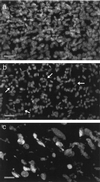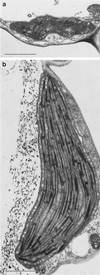Plastid ontogeny during petal development in Arabidopsis
- PMID: 9489024
- PMCID: PMC35139
- DOI: 10.1104/pp.116.2.797
Plastid ontogeny during petal development in Arabidopsis
Abstract
Imaging of chlorophyll autofluorescence by confocal microscopy in intact whole petals of Arabidopsis thaliana has been used to analyze chloroplast development and redifferentiation during petal development. Young petals dissected from unopened buds contained green chloroplasts throughout their structure, but as the upper part of the petal lamina developed and expanded, plastids lost their chlorophyll and redifferentiated into leukoplasts, resulting in a white petal blade. Normal green chloroplasts remained in the stalk of the mature petal. In epidermal cells the chloroplasts were normal and green, in stark contrast with leaf epidermal cell plastids. In addition, the majority of these chloroplasts had dumbbell shapes, typical of dividing chloroplasts, and we suggest that the rapid expansion of petal epidermal cells may be a trigger for the initiation of chloroplast division. In petals of the Arabidopsis plastid division mutant arc6, the conversion of chloroplasts into leukoplasts was unaffected in spite of the greatly enlarged size and reduced number of arc6 chloroplasts in cells in the petal base, resulting in few enlarged leukoplasts in cells from the white lamina of arc6 petals.
Figures








Similar articles
-
The Arabidopsis arc5 and arc6 mutations differentially affect plastid morphology in pavement and guard cells in the leaf epidermis.PLoS One. 2018 Feb 21;13(2):e0192380. doi: 10.1371/journal.pone.0192380. eCollection 2018. PLoS One. 2018. PMID: 29466386 Free PMC article.
-
Effects of arc3, arc5 and arc6 mutations on plastid morphology and stromule formation in green and nongreen tissues of Arabidopsis thaliana.Photochem Photobiol. 2008 Nov-Dec;84(6):1324-35. doi: 10.1111/j.1751-1097.2008.00437.x. Epub 2008 Aug 29. Photochem Photobiol. 2008. PMID: 18764889
-
Plant cells without detectable plastids are generated in the crumpled leaf mutant of Arabidopsis thaliana.Plant Cell Physiol. 2009 May;50(5):956-69. doi: 10.1093/pcp/pcp047. Epub 2009 Mar 24. Plant Cell Physiol. 2009. PMID: 19318374
-
Plastid division: evolution, mechanism and complexity.Ann Bot. 2007 Apr;99(4):565-79. doi: 10.1093/aob/mcl249. Epub 2006 Nov 30. Ann Bot. 2007. PMID: 17138581 Free PMC article. Review.
-
Division and dynamic morphology of plastids.Annu Rev Plant Biol. 2014;65:443-72. doi: 10.1146/annurev-arplant-050213-035748. Epub 2014 Jan 22. Annu Rev Plant Biol. 2014. PMID: 24471836 Review.
Cited by
-
Identification and functional characterization of a leucine-rich repeat receptor-like kinase gene that is involved in regulation of soybean leaf senescence.Plant Mol Biol. 2006 Aug;61(6):829-44. doi: 10.1007/s11103-006-0052-5. Plant Mol Biol. 2006. PMID: 16927199
-
Analysis of carotenoid biosynthetic gene expression during marigold petal development.Plant Mol Biol. 2001 Feb;45(3):281-93. doi: 10.1023/a:1006417009203. Plant Mol Biol. 2001. PMID: 11292074
-
Arabidopsis transcription factor TCP4 represses chlorophyll biosynthesis to prevent petal greening.Plant Commun. 2022 Jul 11;3(4):100309. doi: 10.1016/j.xplc.2022.100309. Epub 2022 Mar 3. Plant Commun. 2022. PMID: 35605201 Free PMC article.
-
Global identification of target genes regulated by APETALA3 and PISTILLATA floral homeotic gene action.Plant Cell. 2003 Jan;15(1):207-22. doi: 10.1105/tpc.006353. Plant Cell. 2003. PMID: 12509532 Free PMC article.
-
Distinctive Gene Expression Patterns Define Endodormancy to Ecodormancy Transition in Apricot and Peach.Front Plant Sci. 2020 Feb 28;11:180. doi: 10.3389/fpls.2020.00180. eCollection 2020. Front Plant Sci. 2020. PMID: 32180783 Free PMC article.
References
-
- Brett DW, Sommerard AP. Ultrastructural development of plastids in the epidermis and starch layer of glossy Ranunculus petals. Ann Bot. 1986;58:903–910.
-
- Dupree P, Pwee K-H, Gray JC. Expression of photosynthetic gene-promoter fusions in leaf epidermal cells of transgenic tobacco plants. Plant J. 1991;1:115–120.
-
- Falk H. Chromoplasts of Tropaeolum majus L.: structure and development. Planta. 1976;128:15–22. - PubMed
-
- Kirk JTO, Tilney-Bassett RAE (1978) The Plastids. Elsevier/North Holland Biomedical Press, Amsterdam, The Netherlands
-
- Lawrence SD, Cline K, Moore GA. Chromoplast development in ripening tomato fruit: identification of cDNAs for chromoplast-targeted proteins and characterisation of a cDNA encoding a plastid-localised low-molecular weight heat shock protein. Plant Mol Biol. 1997;33:483–492. - PubMed
Publication types
MeSH terms
LinkOut - more resources
Full Text Sources
Molecular Biology Databases

